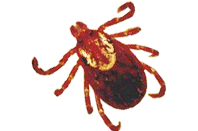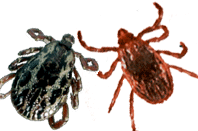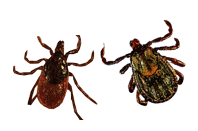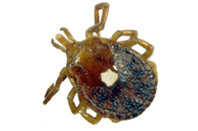Rid your home of unwanted pests with guaranteed service from Eagle Pest Control.
Eagle’s pest control maintenance service is designed to keep you home pest-free by creating a protective barrier around the exterior of your home. We use extremely effective, long-lasting products that are safe to use in homes, schools, day cares, and food service establishments. Our full-service maintenance plans are inclusive of all general household pests. You will have a pest-free environment, both inside and outside of your home or business – Guaranteed.For Service calls and pricing, please call 502-243-1600
Ticks

American Dog Tick
The American dog tick is named for its distribution - only in north America, and its preference to feed on dogs. Ticks are parasites, that burrow their mouthparts into their host to feed on their blood. The American dog tick ranges anywhere from 1/8" to 5/8" long depending on how much blood it has ingested. Coloring is brown, with gray markings.
The markings can vary from the picture, depending on the tick's sex. These ticks aren't a house pest, and can't complete their life indoors. Outdoors, these pests sometimes wait on grasses to latch onto a host animal. These ticks can usually be carefully removed without complications, but if undetected and allowed to feed, can cause serious problems or death. Though uncommon, this and many other parasitic pests can be a carrier of disease.

Brown Dog Tick
The brown dog tick isn't always brown, but does primarily host on dogs. Between 1/8"-1/2" depending on how full of blood they are, individuals of this group of ticks can vary in appearance. This tick, like others, burrows its mouthparts into its host to feed on their blood. Shown are two examples, but this tick can be colored from red-brown to gray-green.
The brown dog tick prefers dryer, sheltered locations unlike other ticks, and doesn't do very well outdoors. They have a tendency to work their way into high places, especially when laying eggs. Later they come down to feed on a host. Brown dog ticks rarely feed on humans.

Pacific/Western Blacklegged Tick
The western/pacific blacklegged tick is named for its distribution on the west coast, and darker legs than its body. They are smaller ticks ranging from 1/16" to 3/8" long, their size depending on how full of blood they are. The picture on the right shows an engorged tick. These parasites like mammals such as humans, to host on. They prefer outdoor environments and will wait on grass or brush for an animal to latch onto.
This tick is the main transmitter of Lyme disease in our area of Kentucky. Lyme disease is a serious one, wreaking havoc on different parts of the body. If bitten by a tick, watch out for an early warning sign of Lyme disease - a circular rash on the body. If gone untreated, chronic effects on muscles, breathing, and the nervous system can occur.

Lone Star Tick
A pest of livestock and wildlife. All life stages readily attack humans. This is probably the tick most often encountered by people to the south and will await a host along trails and pathways.. This tick is known to transmit Rocky Mountain spotted fever, Human Ehrlichiosis, Tularemia, and American Q fever. Active from early spring to late fall. The females is capable of laying 9-12,000 eggs.
This tick is about 1/8 inch long and is dark brown. The tick receives its name from the lone white spot on the dorsal shield of the female. The male has nonconnected white markings around its posterior margin. Mouthparts are long compared to most other ticks.
Additional resources are available to assist you in identifying and controlling insects.
Insect Identification
With over 1 million identified species of insects and spiders in the world with many more still awaiting discovery. Use Insect Identification categories to discover your species.
Pest World
For expert pest control tips and resources surf to Pest World.
Pest World for Kids
For fun pest facts and kid-friendly bug and insect research, head to Pest World for Kids.
